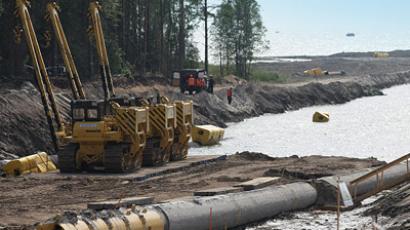Nord Stream Launched: Russian Gas flows to Europe
After 13 years of planning and two years of construction, the Nord Stream pipeline has started to deliver its first supplies of Russian gas to an estimated 26 million homes in the EU.
President Medvedev and German Chancellor Angela Merkel set the gas flowing by releasing a symbolic valve to open the pipeline along which Russian gas will reach Europe.Talking at the Nord Stream gas pipeline launch ceremonies in the German town of Lubmin, Medvedev hopes Nord Stream will strengthen energy security in Europe."We are interested in the development of the gas distribution infrastructure, erecting modern and environmentally-friendly generating capacity, including steam-to-gas power stations. We are counting on there being no kinds of artificial barriers on the road of co-operation, even in spite of the differing approaches that are heard," he said.
The Nord Stream pipeline, passing under the Baltic Sea from the city of Vyborg in Russia’s Leningrad region to Germany´s Greifswald, will be unique in many ways. It is the longest sub-sea pipeline in the world – over 1,200 kilometers – and it will operate under the highest pressure as well.At 7.4 billion euro, it is undoubtedly expensive, but the pipeline is expected to function for up to 50 years, so there is plenty of time to generate a return, in social as well as economic terms. Bypassing all transit countries, it´ will make gas supplies from Russia, which make up about 25% of total gas supplies to Europe, more certain. The disruptions of 2007 and 2008, when Gazprom and Naftogaz of Ukraine failed to agree on supplies to Ukraine and transit of supplies for the EU, will remain firmly in the past. Chris Weafer, chief economist at Troika Dialog, adds that the new pipeline, the first since the end of the Soviet Union, will mark a qualitatively new stage of the “economic and political relationship between Russia, Germany and the core EU countries.”“Germany explicitly accepts Russia as a reliable energy partner at a time when there are major question marks over its nuclear program and over the reliability of possible alternative gas supply routes into Europe,” Weafer added.According to Dirk von Ameln, a director at the Nord Stream project, the pipeline capacity will already have reached 1 million cubic meters an hour by 16.00, Moscow time, which means an annual delivery capacity of 8.5 billion cubic meters. This should grow to 27.5 billion cubic meters of gas a year, von Ameln said, adding that after the second line is launched in autumn 2012, deliveries will double to 55 cubic meters a year.This project comes at a time when demand for Russian gas is set to grow sharply. Earlier, Russia’s gas exporter, Gazprom, forecast that it would rise to 200 billion cubic meters a year by 2030.














